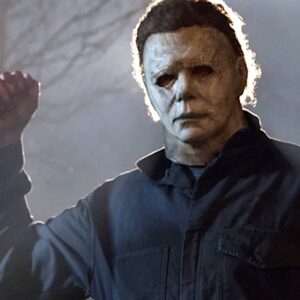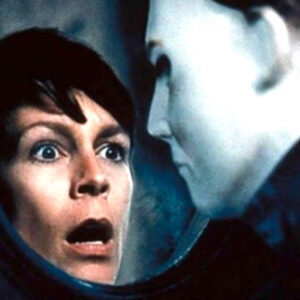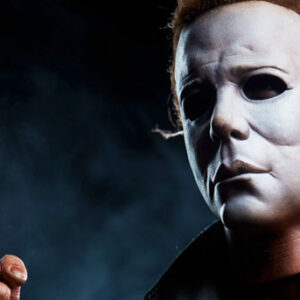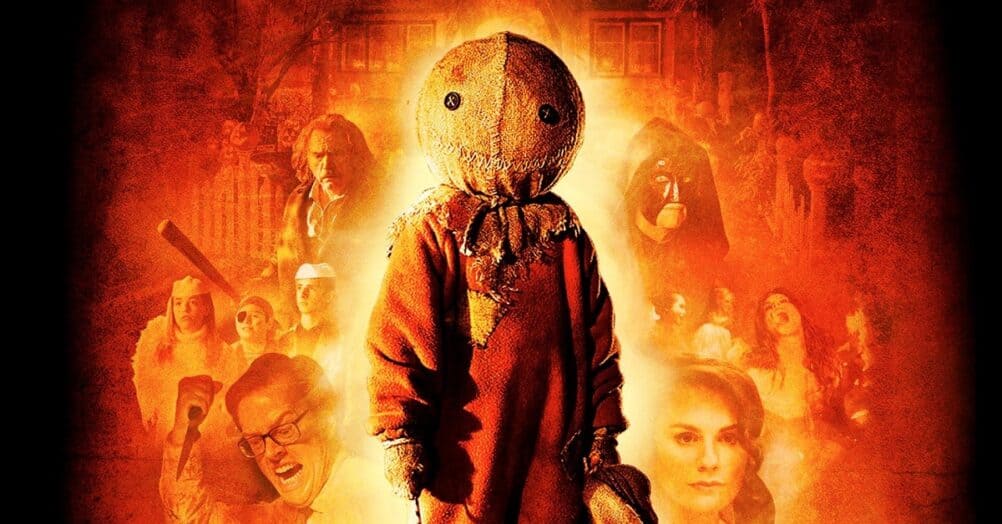Last Updated on August 29, 2024
With this video, we’re continuing our journey through the various timelines in the Halloween franchise (you can pick up the Blu-ray collection of the Halloween series HERE), and now we’ve reached the point where Halloween movies started flat-out ignoring previous entries. Halloween III: Season of the Witch had been set in a different universe than the first two Halloween movies, but it did still acknowledge their existence, as John Carpenter’s Halloween was shown on TV in that film. But Halloween 4 takes us back to the story that Halloween and Halloween II had started, the story of masked slasher Michael Myers. To do so, the film had to just forget Halloween III ever happened – and while it would be controversial when future sequels decided to ignore previous movies, most fans didn’t mind that Halloween III had been set aside. They were just happy to be seeing The Return of Michael Myers.
The fact that Halloween III’s attempt to turn this into an anthology series was a failed experiment was something that everyone quickly accepted. Halloween creators John Carpenter and Debra Hill were still involved when executive producer Moustapha Akkad laid down the law and said Michael Myers would be coming back for Halloween 4. Carpenter and Hill were even responsible for hiring part 4’s first screenwriter: Dennis Etchison, who had written the novelizations of Halloweens II and III under a pseudonym. The plan was to have Etchison write the script and Joe Dante direct the film. But Etchison took a supernatural approach to bringing Michael Myers back to Haddonfield, Illinois, and that wasn’t what Akkad was looking for. When he rejected the Etchison script, Carpenter and Hill sold their stake in the franchise to him and walked away.
The Halloween 4 we did get came from the creative team of director Dwight H. Little and writer Alan B. McElroy, and after an atmospheric title sequence that perfectly captures the look and feel of a Midwestern Halloween, we find out how they overcame the challenge of bringing Michael Myers back without Jamie Lee Curtis. While Myers seemed to be choosing victims at random in the first Halloween, Halloween II had established that he was specifically pursuing Curtis’s babysitter character Laurie Strode because she was his sister. He had killed his older sister on Halloween night when he was just six years old, and after a fifteen year stay in a mental institution he had escaped to kill his younger sister on Halloween. If you don’t have Curtis as Laurie, what is his motivation? Of course, you go to the next generation in the bloodline. Comatose since Dr. Samuel Loomis set him on fire at the end of Halloween II, Myers regains consciousness after ten years when he hears that he has a niece.
That niece is seven-year-old Jamie Lloyd, played by Danielle Harris. As of Halloween 1988, eleven months have passed since her parents died in a car accident, and Jamie is now in the care of the Carruthers family, the most prominent member of her adoptive family being the teenage Rachel Carruthers, played by Ellie Cornell. Rachel has a date set up on Halloween, but when her parents have an important event to attend and the usual babysitter has a broken ankle, Rachel gets stuck watching Jamie and taking her trick-or-treating – not realizing that Jamie has a homicidal uncle who is stalking the streets of their hometown of Haddonfield, looking for the little girl and knocking off anyone who gets in his way.
Luckily for Jamie and Rachel, Donald Pleasence is also back as Dr. Loomis, even though he was caught in an explosion with Myers at the end of Halloween II. Myers ended up in a coma, but Loomis was somehow virtually unscathed, he only sports a bit of scarring on his face and on a hand that he keeps covered with a glove. Just like in the first two movies, Loomis is on the trail of his former patient, out to stop his reign of terror.
For filmmakers stuck with the “Michael Myers is out to kill his relatives” concept introduced in Halloween II, and also stuck with having to bring back the villain without the heroine, Little and McElroy did an awesome job of continuing the Myers story. With Halloween 4, they delivered a film that ranks highly among the best slashers of the 1980s, mixing the Halloween style with an ‘80s vibe that today really enhances its nostalgia factor. When he was hired to write the script, McElroy only had eleven days to knock it out because the Writers Guild was about to go on strike. He did it, and you can see in the finished film that he was aided by the fact that he stuck very closely to the structure of the first movie. There are times when Halloween 4 is a direct copy of the first Halloween, it’s just bigger, flashier, and bloodier. Michael Myers escaped from the mental institution without killing anyone in the first movie, but when he escapes from custody in part 4 he massacres an ambulance full of people and leaves a bloody mess. He killed a mechanic to steal his overalls off screen the first time, he kills the mechanic on screen here – and Loomis doesn’t just find evidence that Myers did this like he did in ’78, he finds the body, sees Myers, and there’s gunfire and an explosion. And in the end, Myers doesn’t just get shot six times by one person. He gets pumped full of lead by a bunch of police officers and knocked into a mine shaft.
Halloween 4 ends with a moment that echoes the beginning of the first Halloween. Myers killed his older sister while wearing a clown costume, and the implication is that evil is hereditary when Jamie Lloyd, wearing a clown costume, picks up a pair of scissors and starts slashing away at her adoptive mother.
This “everything old is new again” approach worked out well. Halloween 4 was a hit, and fans were very happy to see Michael Myers rampaging across the screen once again. Jamie Lee Curtis may have been missed, but viewers were quite impressed by child actress Danielle Harris. Her performance as Jamie Lloyd endeared her to a lot of horror fans, and she remains a prolific genre icon to this day.
The return of Michael Myers was a triumphant one, and Akkad wanted to strike while the iron was hot. Halloween 5 reached theatres the very next year… and things didn’t go so smoothly with that one, mainly because the filmmakers made the mistake of overthinking and over-complicating a very simple concept. Michael Myers is a masked maniac who kills people on Halloween, that’s as complicated as Halloween ever needed to be. The “Laurie Strode is his sister” addition was unnecessary, and the unnecessary additions go much further in both the fifth and sixth films.
Halloween 5 (which marketing materials refer to as Halloween 5: The Revenge of Michael Myers) begins by showing us how exactly Michael Myers escaped from the ending of the previous film. He’s swept down a river and ends up at the home of someone who takes care of him as he lies dormant for the next year. This would have made some sense if the film had stuck with the original intention of director Dominique Othenin-Girard and his co-writers, which was to have the caretaker be an occultist called Doctor Death. This guy would have been a Myers fan responsible for drawing a symbol on the killer’s wrist that represents “eternal life”. Of course someone called Doctor Death would keep Myers in their house for a year. But after the scenes with Doctor Death were filmed, the decision was made to replace him in reshoots. In the finished film, Myers is taken in by an old hermit, and it’s not clear why this guy lets him sleep in his shack for a year. We still see the symbol on Myers’ wrist, but since we didn’t see Doctor Death or the hermit put it there, we have to assume this was something that was always on his wrist, we just never saw it. Why the hell does Michael Myers have a symbol tattooed on his wrist?
This whole symbol thing gets even stranger when a Man in Black catches a bus into Haddonfield and we see that this mysterious person also has that symbol tattooed on their wrist. Who is the Man in Black and what is this symbol supposed to mean now? The fact is, no one involved with Halloween 5 had any idea. The filmmakers just randomly decided to throw the Man in Black into the mix and have him lurking around in a handful of scenes throughout the movie. The only possible explanation that was considered during the filming was that the Man in Black might be Michael Myers’ twin brother we had never heard about before. That’s why both characters are played by the same person, stuntman Don Shanks.
When Michael Myers wakes up just in time for Halloween 1989, we find that Jamie has become more like her uncle in that she no longer speaks. She’s a patient at a Children’s Clinic and is said to be nine years old in this one, so she somehow aged two years in just one year. She has also developed a psychic connection to her uncle, so sometimes she is able to see through Michael Myers’ eyes as he stalks and kills the people around her. Among his victims is Rachel, and killing her off was a very unpopular move. Fans who came to care about her in Halloween 4 were not happy to see her make an early exit from Halloween 5, especially since she’s replaced by one of the most disliked characters in the entire franchise, the very wacky Tina, played by Wendy Kaplan.
This sequel is bogged down by bad writing and poor decisions, but it does have some classic scenes of slashing and suspense, including a chase scene involving a Camaro and an incredible climactic sequence that takes place inside the crumbling, old Myers house. That location was another questionable choice, since the house looks nothing like the one we saw in the first two movies, but what happens inside that place is great. Then everything falls apart with a cliffhanger ending where the Man in Black walks into the Haddonfield Police Department with a machine gun and rescues Myers from a jail cell. Nobody knew why that happened, they left that up to the makers of Halloween 6 to figure out. Part 6 wouldn’t come along until six years after the release of 5, so the mystery of the Man in Black was on the minds of Halloween fans for quite a long time.
The mystery was solved in the film where the Michael Myers saga went completely off the rails, Halloween: The Curse of Michael Myers, directed by Joe Chappelle. By the time you’re done watching it, you might wish it had been directed by Dave Chappelle. Although scripts involving virtual reality and Myers being dragged to Hell by demons just like Jason Voorhees was in Jason Goes to Hell were rightfully rejected, the Halloween 6 we got still went in a direction these movies never should have. It explains Myers’ evil by saying that he’s the latest in a long line of people that have been afflicted by the curse of Thorn, which compels the cursed person to kill their family – and this urge to kill is especially strong when a constellation of stars in the form of the Druid Thorn rune appears in the sky. That symbol on Myers’ wrist, that’s the Thorn rune, which is why he’s now surrounded by a Druid cult that has kept him safe for the six years since the events of part 5. This cult idea didn’t come out of nowhere, screenwriter Daniel Farrands was drawing inspiration from the novelization of the first film, which dug into the Druid roots of the Halloween holiday, as well as from the scene in Halloween II when Loomis discovers that Myers has written the word “Samhain” on a wall at a crime scene, something which always felt out of character for Myers and was another sure sign that John Carpenter was feeling desperate when trying to give part 2 some kind of story.
The leader of the cult is the Man in Black, who is revealed to be Dr. Wynn, a character we previously saw in the first Halloween and is now played by Mitchell Ryan. Why exactly Wynn came to Haddonfield in the previous movie is never explained, nor do we find out why a doctor who leads a cult had to resort to catching a bus to get there. What we do discover is that both Myers and Jamie Lloyd – now a teenager played by J.C. Brandy because Dimension Films didn’t want to bring Danielle Harris back – have been in the custody of the cult ever since the ending of part 5. And somewhere along the line, Jamie got pregnant, because The Curse of Michael Myers begins with her giving birth to a boy who’ll be named Steven.
Which brings us to the fact that there are two very different cuts of The Curse of Michael Myers out there. There’s the theatrical cut, which has flashy editing and plays down the cult aspect as we get near the end, and there’s the so-called Producer’s Cut, which goes all-in on the cult idea. There’s no indication of who fathered Jamie’s baby in the theatrical version of the movie, while the Producer’s Cut implies that Myers impregnated his niece during some kind of cult ritual. It seems the cult needs to sacrifice this baby so the curse of Thorn will be passed on to someone else – and it looks like the next candidate is a young Haddonfield kid named Danny, the grandson of Laurie Strode’s adoptive father’s brother. This is really starting to sound like a soap opera, isn’t it? Danny, his mom, his uncle, and his grandparents now live in the old Myers house, which looks more like it did in the first two movies than it did in part 5.
Living across the street is a grown-up Tommy Doyle, the kid Laurie was babysitting in the first movie. Now he’s played by future Ant-Man Paul Rudd, and he has figured all of this Thorn stuff out. He also ends up taking care of baby Steven and trying to keep him safe from Myers after Jamie Lloyd gets killed. Tommy is aided in this endeavor by Danny’s mom Kara, played by Marianne Hagan, and by good old Dr. Loomis, who is shocked to find out his old buddy Wynn was the Man in Black. After Myers stalks through the streets of Haddonfield on yet another Halloween night, really putting a damper on the movement to bring Halloween celebrations back to the town after they’ve been banned for years, the climax of the film takes place at Smith’s Grove Sanitarium, the same place Myers escaped from at the start of the first movie.
The ending is where the theatrical cut and the Producer’s Cut really go off in different directions. Committed to the cult idea, the Producer’s Cut has Myers immobilized with a magic trick that Tommy pulls off with a circle of stones. It’s the power of the runes! Then Wynn and Myers swap clothes while Loomis receives the Thorn curse and has to become the new leader of the cult… Yeah, they actually filmed that stuff. They thought it was a good idea at the time. The theatrical cut, on the other hand, ditches the cult nonsense and has Myers massacre a bunch of the cult members, then adds in its own brand of nonsense with mention of genetic engineering and shots of fetuses in aquariums. How did the Halloween franchise get here? And when Tommy gives Myers a beat-down with a lead pipe, why is there green liquid leaking out of his mask?
These are questions that will never be answered, because the producers realized they had driven the series into a dead-end with all this stuff. The cult, the genetic engineering, the runes, the green liquid, all of that was left behind when development began on the next Halloween sequel. Those ideas weren’t the only things disregarded, either. To get Halloween and Michael Myers back to the basics, the decision was made to act like parts 4, 5, and 6 never happened. Jamie Lloyd never existed. And Laurie Strode never died, she just changed her name to Keri Tate. The seventh Halloween would act like it was the third Halloween, serving as a direct sequel to the first two films. A lot of fans who had been invested in the story of Jamie Lloyd were disappointed to see her get written out of existence, but other fans were very excited to see Laurie Strode / Jamie Lee Curtis and Michael Myers face off again for a rematch twenty years in the making.
We’ll talk about Halloween H20: 20 Years Later and that whole new Halloween timeline in the next video. In the meantime, thank you for watching our show. If you like what you see, please subscribe to our JoBlo Horror Videos channel, tell your friends who like this sort of content, and turn on the bell to receive notifications for all of our latest videos. We’re an independent company and we appreciate all of your support!
The previous episode of The Timelines of Halloween can be seen below, along with samples of a couple of our other series. To see more, head over to the JoBlo Horror Videos YouTube channel – and subscribe while you’re there!



















Follow the JOBLO MOVIE NETWORK
Follow us on YOUTUBE
Follow ARROW IN THE HEAD
Follow AITH on YOUTUBE